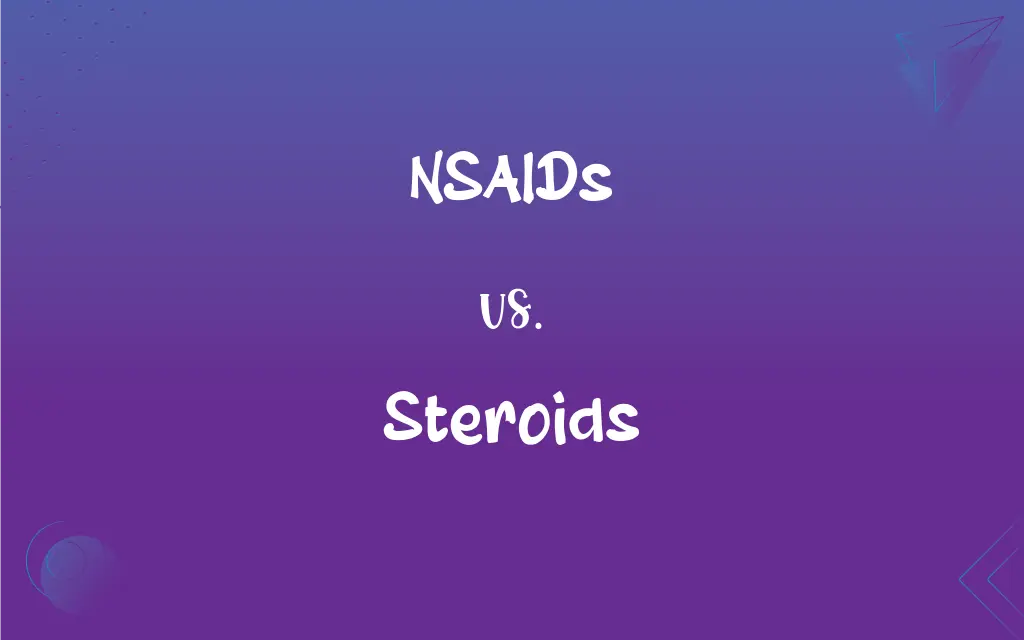NSAIDs vs. Steroids: What's the Difference?
Edited by Janet White || By Harlon Moss || Updated on October 29, 2023
NSAIDs reduce inflammation and pain by blocking enzymes, while steroids reduce inflammation by suppressing the immune system.

Key Differences
NSAIDs, or Nonsteroidal Anti-Inflammatory Drugs, work by inhibiting enzymes that produce prostaglandins, which cause inflammation and pain. Steroids, also known as corticosteroids, function differently by suppressing the immune system to reduce inflammation.
NSAIDs are commonly used for pain relief, such as headaches or arthritis. Steroids, on the other hand, are often prescribed for autoimmune conditions, allergies, and asthma because of their potent anti-inflammatory effects.
The risks associated with NSAIDs include gastrointestinal issues and increased risk of heart problems with long-term use. Steroids, while effective, can lead to side effects like weight gain, mood changes, and increased infection risk.
Over-the-counter NSAIDs like ibuprofen and aspirin are widely available. Steroids, such as prednisone, are typically prescription-based due to their powerful and systemic effects.
NSAIDs are often used for short-term pain relief. Steroids may be used for longer durations in chronic conditions, requiring careful monitoring due to their significant side effects.
ADVERTISEMENT
Comparison Chart
Primary Use
Pain relief, fever reduction
Treat inflammation, autoimmune disorders
Mechanism
Inhibit prostaglandin-producing enzymes
Suppress immune system response
Availability
Over-the-counter and prescription
Mainly prescription-based
Common Forms
Tablets, gels, creams
Pills, injections, inhalers
Side Effects
Gastrointestinal issues, increased heart risk
Weight gain, mood changes, infection risk
ADVERTISEMENT
NSAIDs and Steroids Definitions
NSAIDs
NSAIDs can lower fever.
She took an NSAID to bring down her high fever.
Steroids
Steroids can mimic certain hormones.
Corticosteroids, a type of steroid, mimic cortisol.
NSAIDs
NSAIDs are used to alleviate pain.
Ibuprofen, an NSAID, helped relieve her headache.
Steroids
Steroids are usually obtained by prescription.
She got a prescription for steroids to treat her rash.
NSAIDs
NSAIDs work by inhibiting specific enzymes.
As an NSAID, aspirin inhibits enzymes causing pain.
Steroids
Steroids are used to reduce inflammation.
To control his asthma, he uses an inhaler with steroids.
NSAIDs
NSAIDs reduce inflammation in the body.
After his injury, the doctor prescribed an NSAID to reduce swelling.
Steroids
Steroids suppress the immune system.
The doctor prescribed steroids to treat her autoimmune disease.
NSAIDs
NSAIDs are nonsteroidal, meaning they don't contain steroids.
For his joint pain, he prefers NSAIDs over steroids.
Steroids
Steroids come in various forms.
For his condition, he was given steroids in pill form.
NSAIDs
A nonsteroidal anti-inflammatory drug, such as ibuprofen.
Steroids
Any of numerous fat-soluble organic compounds that have a core structure of 17 carbon atoms arranged in four rings, found naturally in animals, plants, and fungi, or produced synthetically. Steroids include the sterols (such as cholesterol), sex hormones (such as estrogen and testosterone), corticosteroid hormones (such as cortisol), bile acids, and anabolic steroids.
Steroids
(Informal) An anabolic steroid.
Steroids
Plural of steroid
FAQs
What conditions are steroids prescribed for?
Steroids are prescribed for autoimmune diseases, allergies, asthma, and severe inflammation.
Do NSAIDs help with menstrual cramps?
Yes, NSAIDs are often used to alleviate menstrual cramps.
Can NSAIDs be bought over-the-counter?
Yes, many NSAIDs are available over-the-counter, like ibuprofen and aspirin.
Do NSAIDs have side effects?
Yes, NSAIDs can cause gastrointestinal issues, and long-term use may increase heart risk.
Can NSAIDs be used for headaches?
Yes, NSAIDs like ibuprofen are often used for headache relief.
Can steroids affect mood?
Yes, steroids can cause mood swings and changes in emotional state.
Do steroids help with allergic reactions?
Yes, steroids are often prescribed for severe allergic reactions.
Are inhaled steroids safe?
Inhaled steroids, used for conditions like asthma, are generally safe under medical guidance.
Can steroids lead to increased infection risk?
Yes, since steroids suppress the immune system, they can increase the risk of infections.
Can NSAIDs be taken with alcohol?
It’s not recommended to take NSAIDs with alcohol as it can increase the risk of stomach problems.
Are there natural alternatives to steroids?
Some conditions may benefit from natural anti-inflammatory agents, but they are not direct substitutes for steroids.
How do steroids reduce inflammation?
Steroids reduce inflammation by suppressing the immune system's response.
Do NSAIDs affect blood clotting?
Some NSAIDs, like aspirin, can affect blood clotting and reduce clot formation.
Can steroids cause weight gain?
Yes, one of the side effects of steroids can be weight gain.
Is ibuprofen an NSAID?
Yes, ibuprofen is a commonly used NSAID.
Can NSAIDs be used daily?
NSAIDs can be used daily for some conditions, but long-term use requires medical supervision.
Are there different types of steroids?
Yes, there are different types, including corticosteroids and anabolic steroids.
Are NSAIDs effective for arthritis?
Yes, NSAIDs are commonly used to relieve pain and inflammation in arthritis.
What are NSAIDs used for?
NSAIDs are used for pain relief, reducing inflammation, and lowering fever.
Are steroids safe for long-term use?
Long-term use of steroids can have significant side effects and should be monitored by a doctor.
About Author
Written by
Harlon MossHarlon is a seasoned quality moderator and accomplished content writer for Difference Wiki. An alumnus of the prestigious University of California, he earned his degree in Computer Science. Leveraging his academic background, Harlon brings a meticulous and informed perspective to his work, ensuring content accuracy and excellence.
Edited by
Janet WhiteJanet White has been an esteemed writer and blogger for Difference Wiki. Holding a Master's degree in Science and Medical Journalism from the prestigious Boston University, she has consistently demonstrated her expertise and passion for her field. When she's not immersed in her work, Janet relishes her time exercising, delving into a good book, and cherishing moments with friends and family.
































































